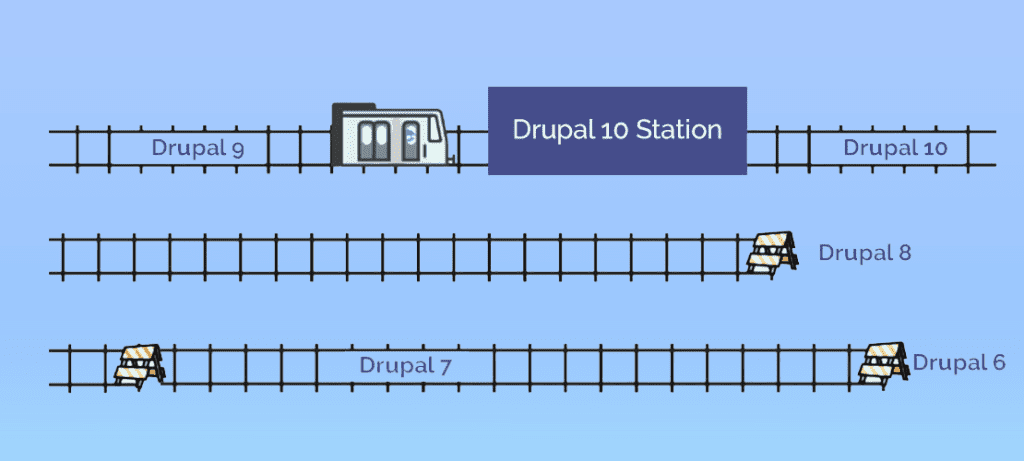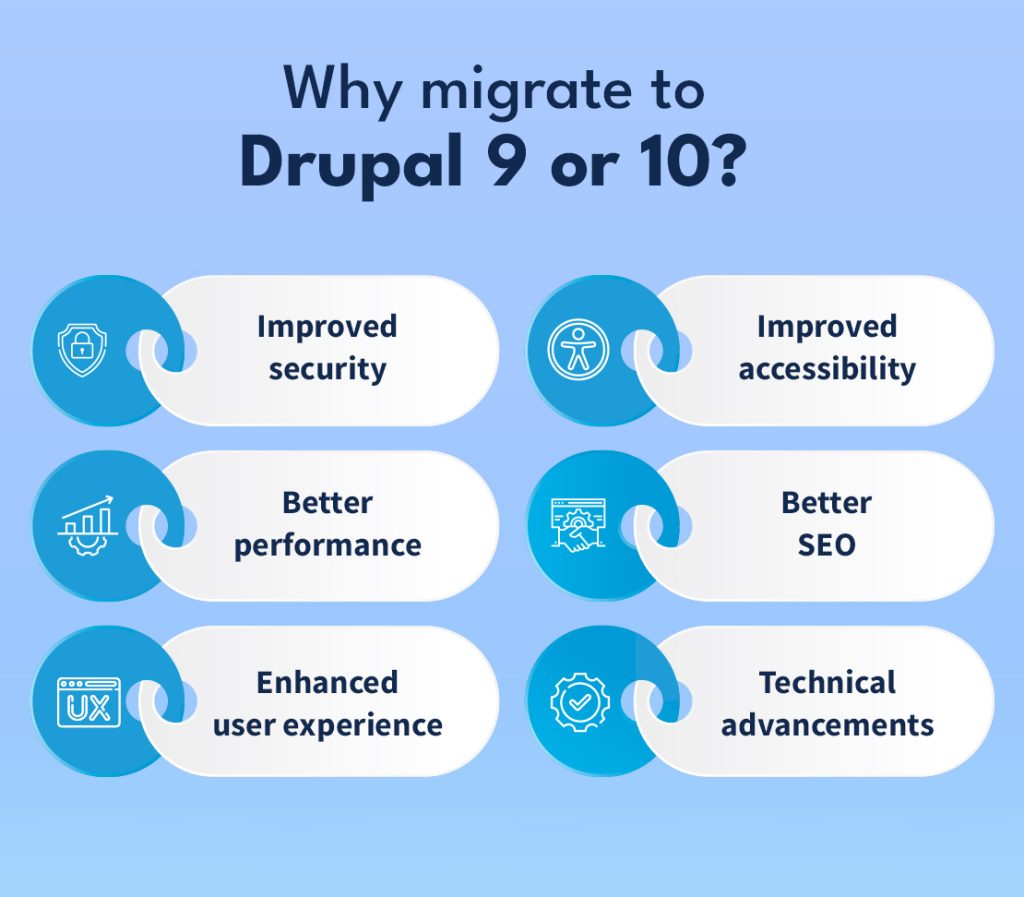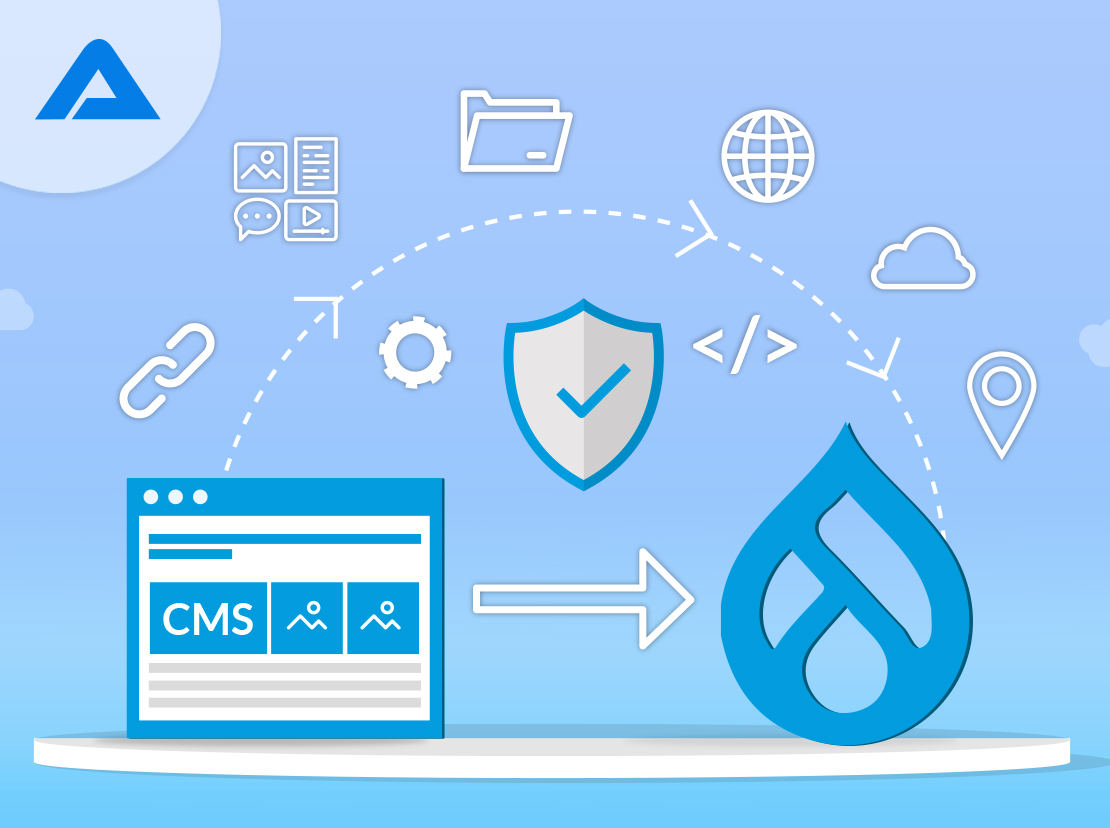Drupal is a content management system (CMS) that has been providing robust and scalable solutions for websites and applications since 2001. Over the years, it has evolved significantly, adapting to the changing needs and demands of the web world. With Drupal 9, the platform has taken a giant leap forward, offering an array of new features, improved performance, and an enhanced user experience. The upgrade from Drupal 8 to Drupal 9 is an exciting opportunity for users and organizations to reap the benefits of this powerful platform. This article will provide a comprehensive overview of Drupal migration, including the process’s what, why, when, and how.
History and Milestones of Drupal:
Drupal is a content management system (CMS) that was first released in 2001 by its founder, Dries Buytaert. Over the years, Drupal has grown to become one of the world’s most popular and widely-used open-source CMS platforms. Here are some of the key milestones in the history of Drupal:

2001: Drupal is first released as an open-source platform.
2011: Drupal 7 is released, offering a range of new features and improvements, including improved usability and an updated interface.
2015: Drupal 8 is released, offering a significant leap forward in functionality and performance. This release included various new features, including multilingual support, improved accessibility, and an updated user interface. The release of Drupal 8.0.0 marked a significant milestone in the evolution of the platform, offering improved performance, enhanced security, and a range of new features and functionalities.
2020: Drupal 9 is released, offering a range of new features and improvements, including enhanced security, improved performance, and a more user-friendly interface.
2022: Drupal 10 is the latest version of the Drupal content management system (CMS). It was released on December 14, 2022, and it is the first version of Drupal built with modern technology and standards. Drupal 10 offers a range of new features and improvements over its predecessor, Drupal 9, including enhanced security, improved performance, and a more user-friendly interface. Additionally, Drupal 10 is fully compatible with modern web technologies and offers developers a range of tools and resources to create custom applications and websites. With its modern architecture and cutting-edge technology, Drupal 10 is poised to become one of the world’s most widely-used open-source CMS platforms.
Drupal has come a long way since its inception in 2001, and today, it is widely recognized as a powerful and flexible platform for building websites and applications. With its rich feature set, robust security, and active development community, Drupal remains a popular choice for organizations of all sizes and across all industries.
Drupal Stats:
According to SimilarTech, the top industries using Drupal are education, government, and non-profit organizations.
According to BuiltWith, the United States, India, and Canada are the top countries using Drupal.
Big names using Drupal:
- US Department of Transportation – (Drupal 9)
- The United Nations (Drupal 7)
- NASA (Drupal 7)
- Tesla (Drupal 9)
- The University of Oxford (Drupal 9)
What is Drupal Migration?
Drupal migration refers to the process of transferring content, configurations, and data from one version of Drupal to another or from another CMS platform to Drupal. It involves mapping the data from the old system to the new one, ensuring that everything is accurately transferred and functional. This process is critical for organizations that want to upgrade their websites or applications, as it ensures a smooth transition and helps to maintain data integrity and user experience.

Are you interested in working with AddWeb Solution to help build your nonprofit’s Drupal website? Our team has extensive Drupal experience.

Pooja Upadhyay
Director Of People Operations & Client Relations
When is the right time to migrate?
The right time to migrate to Drupal 9 or 10 depends on several factors, including the size and complexity of your website or application, your organization’s budget and resources, and your overall timeline. This will give organizations enough time to assess their needs, plan their migration, and carry out the process smoothly.
Drupal 7 to Drupal 9/10 Migration
Migrating from Drupal 7 to Drupal 9 or Drupal 10 requires careful planning and execution to ensure a smooth transition. Here is a high-level overview of the steps involved in the process:
Plan your migration:
Identify the modules, themes, and custom code used in your Drupal 7 site and determine which ones have a Drupal 9 or 10 version available. Check for any compatibility issues and plan for any necessary modifications.
Back up your site:
Make a backup of your Drupal 7 site and store it securely. This will ensure that you can revert to the previous state if something goes wrong during the migration process.
Upgrade to Drupal 8:
Since Drupal 9 is built on top of Drupal 8, the first step in the migration process is to upgrade from Drupal 7 to Drupal 8.
Upgrade modules:
Check if all of the modules used in your Drupal 7 site are available in Drupal 8, and upgrade them accordingly. If a module is not available, determine if there is a similar module in Drupal 8 that can be used instead.
Upgrade themes:
Check if the themes used in your Drupal 7 site are available in Drupal 8, and upgrade them accordingly.
Upgrade custom code:
Review any custom code used in your Drupal 7 site and make any necessary modifications to ensure compatibility with Drupal 8. Upgrade to Drupal 9: Once you have upgraded to Drupal 8, you can upgrade to Drupal 9. This will involve updating the modules, themes, and custom code used in your site to be compatible with Drupal 9.
Upgrade to Drupal 10 (optional):
If you want to go straight to Drupal 10, you can skip the Drupal 9 step and upgrade directly from Drupal 8 to Drupal 10.
Test your site:
After upgrading, thoroughly test your site to ensure everything works as expected. Pay special attention to any custom code or modules modified during the upgrade process.
Launch your site:
Once you have tested and are satisfied with the results, you can launch your upgraded Drupal 9 or Drupal 10 site to the public.

Drupal 8 to Drupal 9/10 Migration
If you have upgraded to Drupal 8, you are already halfway. Here is a simple step for migrating a Drupal 8 site to Drupal 9 or Drupal 10:
Assess your current website or application:
Before migrating to Drupal 9 or 10, it is essential to assess your current website or application to determine what needs to be migrated and what can be left behind. This includes evaluating your existing content, custom modules, and themes and determining what changes will be required to your website or application to make it compatible with Drupal 9 or 10.
Plan your migration:
Once you have assessed your website or application, you should create a detailed plan for your migration, including a timeline, budget, and resources required. This will help you ensure your migration succeeds and meets your goals and objectives. Choose an upgrade path module: Drupal offers a migration module that can be used to migrate your website or application to Drupal 9 or 10. Choose a module that meets your specific needs and requirements, and ensure that it is compatible with your current website or application.
Prepare for migration:
Preparing your website or application for the migration is essential before you begin. This may include creating backups, testing your migration module, and making necessary changes to ensure compatibility with Drupal 9 or 10.
Perform the migration:
You can begin the migration process once you have prepared your website or application. This may involve importing your content, custom modules, and themes into Drupal 9 or 10 and making any necessary updates to ensure that it is fully compatible with Drupal 9 or 10.
Test and validate your migration:
After you have completed your migration, it is essential to test and validate your website or application to ensure that it is functioning correctly and that all of your content, custom modules, and themes have been appropriately migrated.
Launch your migrated website or application:
Once your migration has been tested and validated, you can launch your migrated website or application to the public.
By following these steps, you can confidently migrate your website or application to Drupal 9 or 10, ensuring that your migration is successful and that your website or application is ready to meet your goals and objectives.
Why migrate to Drupal 9 or 10?
There are several reasons why organizations choose to migrate to Drupal 9 or 10:

Improved security:
Drupal 9 and 10 offer improved security features and protections, making it easier for organizations to secure their websites and applications against potential threats.
Better performance:
Drupal 9 and 10 are designed to offer improved performance, with faster page load times and enhanced stability, making it easier for organizations to build and manage high-performance websites and applications.
Enhanced user experience:
Drupal 9 and 10 offer a range of features and functionalities that enhance the user experience. These features make it easier for users to interact with websites and applications and provide a more efficient and enjoyable experience.
Improved accessibility:
Drupal 9 and 10 are designed to be more accessible, with a range of features and functionalities that make it easier for people with disabilities to interact with websites and applications.
Better SEO:
Drupal 9 and 10 offer improved Search Engine Optimization [SEO] features and tools, making it easier for organizations to optimize their websites and applications for search engines and reach a wider audience.
Technical advancements:
Drupal 9 and 10 are built on the latest technologies, including modern PHP frameworks, making it easier for organizations to build and manage websites and applications that meet their unique needs and requirements.
By migrating to Drupal 9 or 10, organizations can use these and other benefits to improve their websites and applications, reach their goals more effectively, and provide a better user experience.
Some useful notes about Drupal
- Drupal 7 reached end-of-life on November 2023 and will no longer receive security updates or support.
- Drupal 9 & 10 offers improved performance, security, and support for mobile devices and web services.
- Drupal 9 & 10 also includes new features such as improved accessibility and a streamlined administrative interface.
Why choose AddWeb for Drupal migration services?
As a leading Drupal development company, we have expertise and experience in Drupal development & migration. Our team of certified developers has extensive knowledge of the Drupal platform, and we are committed to providing our clients with the best possible experience during the migration process. Our approach is tailored to meet each client’s unique needs, ensuring a smooth and efficient migration process. We use the latest tools and techniques to ensure seamless migration and that all data is properly transferred. Our customer-centric approach, technical expertise, and commitment to quality work set us apart as a leading Drupal development agency. With us, our customers can be confident that their migration will be handled with the utmost care and professionalism.
Conclusion
In conclusion, Drupal migration is critical in upgrading your website and enhancing its performance. It requires careful planning, attention to detail, and the right tools and resources to ensure a smooth and successful process. The key to a successful Drupal migration is to take a step-by-step approach and ensure all aspects are thoroughly planned and executed. From backing up data to testing the new website and monitoring its performance, every aspect of the migration must be carefully considered. With the right approach and the help of a professional Drupal development agency, you can take your website to the next level and enjoy all the benefits of a successful Drupal migration. Whether you want to upgrade your website or build a new one, a step-by-step Drupal Migration Services is a must-consider option.
Frequently Asked Questions
It’s like deciding to renovate your house. Consider Drupal migration when you want to upgrade to a newer version for improved features and security or when switching from another platform to Drupal for enhanced functionality.
Absolutely! It’s like following a roadmap. While you can migrate from any Drupal version to the latest, there are recommended paths to ensure a smooth transition. Check Drupal.org for specific migration paths and guidelines.
Think of it as giving your website a fresh look. Migration generally focuses on content and data, but you may need to update or tweak your theme to ensure compatibility with the latest Drupal version.
Absolutely! It’s like packing for a trip. Drupal migration allows you to select specific content types, configurations, or components to migrate, giving you flexibility in what you want to transfer to the new site.
Think of it as a safety net. Properly plan your migration, back up your data, and thoroughly test the process to identify and address any issues before completing the migration.
Yes! It’s like ensuring everyone is on the same page. Update contributed modules and themes to their latest compatible versions for the target Drupal version to maintain functionality and security.
Think of it as updating your address with the post office. Implement redirects for old URLs to new ones and update metadata using tools like the “Redirect” and “Pathauto” modules to maintain SEO continuity.
It’s like having a supportive community. The Drupal community, documentation, and forums provide valuable resources. You can also seek professional assistance from Drupal developers or agencies for a smooth migration.

Looking for a Drupal Development Agency for Drupal Migration?

Pooja Upadhyay
Director Of People Operations & Client Relations

